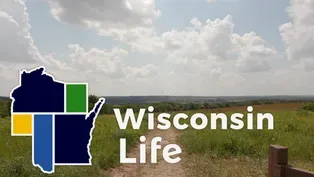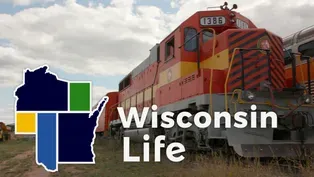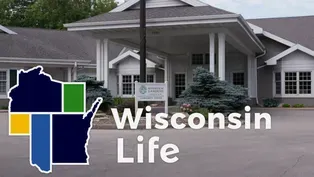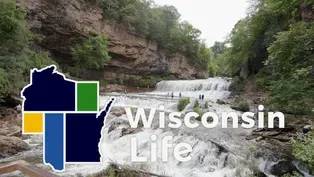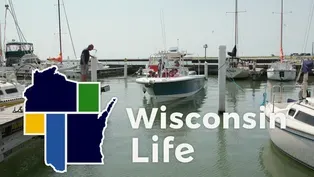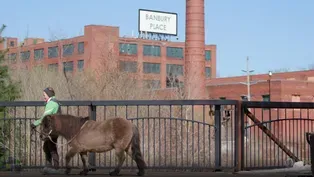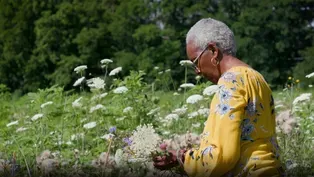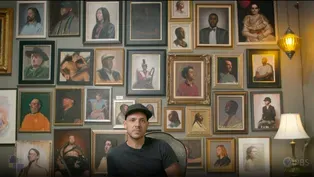
Museum of Wisconsin Art in West Bend
Season 10 Episode 2 | 26m 49sVideo has Closed Captions
Celebrate artists in our state at MOWA, Museum of Wisconsin Art in West Bend.
We visit MOWA, the Museum of Wisconsin Art in West Bend, celebrating classical and contemporary artists from around our state. We also meet an Eau Claire celebrity nicknamed Jack the Magnificent, a Madison portrait artist helping others learn the craft, a naturalist in Fitchburg sharing the power of plants, and we see something odd in Oshkosh.
Problems with Closed Captions? Closed Captioning Feedback
Problems with Closed Captions? Closed Captioning Feedback
Wisconsin Life is a local public television program presented by PBS Wisconsin
Funding for Wisconsin Life is provided by the Wooden Nickel Fund, Mary and Lowell Peterson, A.C.V. and Mary Elston Family, Obrodovich Family Foundation, Stanley J. Cottrill Fund, Alliant Energy, UW...

Museum of Wisconsin Art in West Bend
Season 10 Episode 2 | 26m 49sVideo has Closed Captions
We visit MOWA, the Museum of Wisconsin Art in West Bend, celebrating classical and contemporary artists from around our state. We also meet an Eau Claire celebrity nicknamed Jack the Magnificent, a Madison portrait artist helping others learn the craft, a naturalist in Fitchburg sharing the power of plants, and we see something odd in Oshkosh.
Problems with Closed Captions? Closed Captioning Feedback
How to Watch Wisconsin Life
Wisconsin Life is available to stream on pbs.org and the free PBS App, available on iPhone, Apple TV, Android TV, Android smartphones, Amazon Fire TV, Amazon Fire Tablet, Roku, Samsung Smart TV, and Vizio.
Providing Support for PBS.org
Learn Moreabout PBS online sponsorshipMore from This Collection
Blackhawk Ski Club in Middleton
Video has Closed Captions
We explore the competitive side of winter sports with the Blackhawk Ski Club in Middleton. (26m 48s)
Holi Festival of Colors in Wausau
Video has Closed Captions
We celebrate the Holi Festival of Colors at the Monk Botanical Gardens in Wausau. (26m 49s)
Retzer Nature Center in Waukesha
Video has Closed Captions
Angela visits the wild side of Waukesha at the Retzer Nature Center and planetarium. (26m 48s)
Wisconsin Great Northern Railroad in Trego
Video has Closed Captions
All aboard the Wisconsin Great Northern Railroad for a historic ride in the Northwoods. (26m 48s)
Video has Closed Captions
We tour Riverview Gardens in Appleton, a non-profit offering job training and employment. (26m 48s)
Willow River State Park in Hudson
Video has Closed Captions
Explore Willow River State Park’s stunning waterfall, serene lake and endless trails. (26m 48s)
Sailing Education Association of Sheboygan
Video has Closed Captions
We learn about adaptive sailing with SEAS, the Sailing Education Association of Sheboygan. (26m 48s)
Providing Support for PBS.org
Learn Moreabout PBS online sponsorship- The following program is a PBS Wisconsin Original Production.
- Angela Fitzgerald: Coming up on "Wisconsin Life"... meet Eau Claire's newest four-legged star, an artist helping others br ush up their portrait skills, a naturalist sharing the power of plants, and check out something odd in Oshkosh.
That's all ahead on "Wisconsin Life."
[bright music] ♪ ♪ - Announcer: Funding for "Wisconsin Life" is provided by Lowell and Mary Peterson, Alliant Energy, donors to the Focus Funds for Wisconsin Programs, and Friends of PBS Wisconsin.
- Hello, and welcome to "Wisconsin Life."
I'm Angela Fitzgerald.
I'm standing in front of this architectural beauty, a cultural center celebrating our state's art and artists.
Welcome to MOWA, the Museum of Wisconsin Art.
The museum is in the heart of West Bend, next to the Milwaukee River, and steps away from downtown.
In 1961, Melitta Hedwig Suder-Pick founded the museum to preserve and celebrate the art of her well-known uncle, Carl von Marr, a Milwaukee-born painter.
The collection eventually expanded to showcase other Wisconsin artists, over time, outgrowing the original gallery space.
In 2013, this museum moved into its newly constructed home.
On the second Saturday of each month, the museum hosts a community day, welcoming families to check out the exhibits and create their own art.
The museum also has satellite locations, including in Milwaukee at Saint Kate - The Arts Hotel.
It's all part of an effort to make the museum more welcoming and available to everyone.
[shimmery music] Now, we travel to Eau Claire to meet a local celebrity who's turning heads and winning hearts as he trots through town.
[light country music] Ever stroll through a familiar neighborhood and come across something that seems out of place?
- Christine Fink: We were comin' up the hill and across this prairie down here, and I looked and I said, [record scratch] "Is that a horse?"
[laughs] And my boyfriend says, "I think it is."
[cheerful melody] - That's Rose Johnson and her roommate, Jack.
[clip-clop, clip-clop] Rose is the one in the green jacket, and Jack, well, Jack is Eau Claire's newest resident.
- Rose Johnson: He's a very good citizen, extremely good citizen.
He's very careful.
He likes to interact, but he has very good manners.
- Before we horse around too much, we need to talk about how Rose and Jack met.
[light, playful music] It started at a friend's farm.
- In a little pen, all by himself, is Jack.
And I said, "This little guy is cute.
Why is he in a pen all by himself?"
- The answer, it turns out, had to do with Jack and his affinity for being a bit of an annoyance, sucking and licking the kneecaps of horses and donkeys nearly twice his size.
- 'Cause he was trying so hard to bond with something, and they were just like, "But you're obnoxious."
And he's like, "But I love you."
And so then he's by himself in this little pen, and I'm like, "Oh, he's so cute."
- Having been rehomed five times already, Jack was sadly running out of both friends and options, so Rose did the only natural thing any city-dwelling person would do.
- Good morning.
- She brought Jack home.
- Good morning.
Jack lives on the back of my house, in the city.
- Rose had been going through some issues of her own, both emotionally and physically, when she met Jack.
- We totally needed each other.
He needed someone to bond with that would put up with him sucking on everything, and I needed him in ways I couldn't really-- I didn't understand.
Good Jacky.
- Jack became more than a new roommate to Rose.
- Good job.
- He became her support.
- Big smile, way up high.
Good job.
So I had discussions with the city about what to do with Jack, and we decided mutually that the best way to do that was to make him an ESA, or an emotional support animal.
Good boy.
- Rose found out Jack's encouragement extended well beyond just herself.
- Your friends have come to see you.
- Christine Fink: People see him, they're uplifted.
It makes their day.
And people that have seen him for the first time, it's kind of a shock to see a horse in the middle of the city, but they come out and greet him, and it brings a smile to their face.
[laughter] - Rose Johnson: I never realized the ramifications of that, but he is everyone's emotional support animal because he just makes everybody happy.
So just his existence brings joy to me, primarily, but then also, as kind of a runoff of that, joy to everybody who sees him.
- The two go on daily walks around their neighborhood.
- Sometimes we're walking, sometimes he'll run beside me, and then I'll get on.
And I'm a very small person, and Jack is a tank.
And I am 20% of his weight.
He does not mind my weight in the least.
- According to Jack's vet, Rose riding Jack is completely fine.
The activity provides him with exercise and the neighbors with a little entertainment.
- He has become a huge local celebrity.
I did not plan on becoming Jack's PR manager.
You're just madly grinning at everybody.
He was flapping it at people earlier.
Are you having fun?
Nobody knows my name.
I'm just Jack's mom.
[laughs] - Luckily for Jack's admirers, he rarely turns down the chance at a photo op, unless, of course, you're a Minnesota Vikings fan.
[laughter] - He's a killer ham.
I might have created that monster.
[laughs] I taught him how to smile, and you tap him on the nose, and you say, "Smile, Jack" with a carrot.
And then, as soon as the lip goes up, you stuff the carrot in his mouth.
And so, it took about three times, and he's like, "This is my favorite thing to do in the world."
So now he won't stop.
- Jack has become so popular Rose created a Facebook page to document his shenanigans.
When thinking of a title for the account, one word immediately came to mind.
- He needed a title, and I'm like, "He is the best thing ever."
I'm like, "He's Jack the Magnificent."
[cheerful whistling] And I don't know why that popped into my head, but it just stuck.
And it's really, really true too, because he is totally magnificent.
- Jack's online antics have entertained thousands of people across the country.
And boy, does he know how to put on a show.
- Jack loves wearing costumes.
Jack absolutely adores being dressed up.
He's got fans that have never met him, and everybody's like, "He's a virtual emotional support animal to, like, the whole country."
And he is.
[Jack stomps foot] You wanna go?
- It's true.
Seeing Rose and Jack trotting down the street does seem a bit out of place.
However, get to know them a tad, and the sight becomes a little less odd... - [snorts] - And a little more magnificent.
- Aww.
- He is hilarious.
- [laughs] - Jack is the center of my world.
I-I don't know how I'd do without him.
He's just-- he's my best buddy.
He loves me SO much.
I'm very happy with that.
[laughs] He's pretty special.
I love him so much.
♪ ♪ - Next up, an artist in Madison is painting portraits while helping others brush up their skills.
[soft music] - When you're looking at someone's face, you can-- you can almost tell, like, you know, almost, like, what they did for a living or, like, what type of life they lived.
♪ ♪ Why is that?
I don't know.
But I feel like it's my job to capture that.
[light percussive music] I'm Philip Salamone, and I'm an artist and instructor at Atwood Atelier and also at Madison College in Madison, Wisconsin.
It's hard to say when I realized that I was gonna do art for the rest of my life.
I sort of feel like it chose me, you know?
I tried choosin' other paths, but I couldn't tear myself away from it.
The style of drawing and painting that I do, I'd probably call it traditional or classical, realistic or representational.
I would say that painting from life is kind of a staple of it in the sense of I feel like 'I really thrive on that energy of being there with the model.'
[mellow guitar music] ♪ ♪ My studio is also a school.
It's called the Atwood Atelier.
And it's basically a space for people who were like me when I was younger.
And for so much of my life, I had wanted to learn how to draw or paint realistically.
It's just for people who have that same-- that same bug.
When you're circling that model stand, every artist is emphasizing a different truth.
And they all kinda look like the model, but they all have their own bias on it.
There's a connection with people who have this kind of same really unique interest, and I think just being able to kind of have that connection with people and to not only share knowledge, but to share, like, you know, this is possible.
You know, it's possible to, like, surprise what you thought you were capable of or to make money off of it or just to kind of lead by example in a way, I guess.
[brush strokes] I think just making something that's beautiful and meaningful and skillful is just such an amazing thing to-- I just feel so grateful that I'm able to do that.
[heartfelt music] ♪ ♪ Yeah, it can be so many things.
It can be like-- it's like a meditation, it's like a self-discovery, it's a sense of purpose.
It's just a way to, like-- to process the world and yourself, and it's something to strive for and focus on and to lose yourself in.
If it's-- something about that model really, you know, can bring something magical outta that artist, I think.
♪ ♪ - We're at the Museum of Wisconsin Art, or MOWA, exploring their curated collections spotlighting some our state's most talented creators.
My first stop, I'm meeting up with Laurie Winters, executive director of MOWA, to learn about the museum and how they've engaged the community for over 60 years.
- Laurie Winters: We did something really groundbreaking when we opened this museum ten years ago.
We eliminated single-day admission.
So, when you walk in the door the first time, you automatically become a member.
For us, it's all about engagement, and, you know, expanding our reach throughout the state.
- And it sounds like it's expanding the idea of what is included when you talk about art.
- Absolutely!
For us, we engage with our audiences in a lot of different ways that are kind of unexpected for a museum.
We really have programs that are targeted for all different ages and interests, and I think that's one of the things that makes us so exciting as an institution.
- Yes, and it sounds like you're increasing access to art because art can feel inaccessible... - Mm-hmm.
- When you're not someone who identifies with that medium.
- I would say if you haven't been here before, come and try it on.
- There's a lot to enjoy here, from the permanent collections to the rotating exhibits.
Anwar Floyd-Pruitt, the associate curator of contemporary art, gave me a tour.
I'm so interested in hearing your perspective about this piece.
- Anwar Floyd-Pruitt: This radiant piece by Marianne Fairbanks is called "Tears," but also could be pronounced "tears."
One of my favorite parts of this piece is the way that it just glows, and it feels like it lights up the entire space.
When the sun's coming through the windows just right, it's been a real favorite.
This is a mural painted by John Colt in 1958.
It was originally installed on the campus of Marquette University.
And then they were renovating the building, and they literally cut this mural off of the wall.
The mural remained in the artist's basement for, you know, a number of decades, and it hasn't been shown in approximately 50 years.
- Wow.
- So we're really honored to have this piece here as part of our permanent collection.
There's so much to find in this painting.
It's almost like a "Choose Your Own Adventure" mixed with a "Where's Waldo?"
- That's true.
[laughs] You could just pick one part of it and just focus on that.
- This is a 2021 assemblage by Milwaukee-based artist Della Wells.
Della is a self-taught artist who didn't start making art until later in life.
This piece, it's called "Freedom's Garden," and it is so full of symbolism.
Wells imagines this world called "Mamboland," where Black women are empowered.
So you can see these two figures here are paving the way for women in the future.
- Wow, I feel like there's so much to unpack with this piece.
I might have to spend some more time with it.
But thank you so much for your time with us today.
[shimmery music] Now we head outdoors to frolic through fields in Fitchburg, joining a naturalist foraging for food.
[birds chirping] - M. Afi Lake: This echinacea is in full bloom.
This flower doesn't have a scent, but it's very lovely to look at.
- As a naturalist and a forager, M. Afi Lake sees a food source everywhere she looks.
- Bee balm is very popular in teas, such as Earl Grey tea.
It grows wild over in that field over there.
My philosophy about wild food is it's abundant.
It's also largely forgotten because mostly people consider it just weeds.
- Afi noticed and admired plants from an early age.
- They're just beautiful.
It was just a natural curiosity.
So here is dandelion that's starting to bloom.
Actually, each one of these yellow parts that you see is an individual flower.
I like the variation in textures and colors.
And then that transfers over into actually eating it.
- Tour the outdoors with Afi... - [laughs] I almost overlooked this plant right here.
- And she can find a smorgasbord of things to eat.
- The reason I can eat these things freely is because none of this is sprayed with pesticides, so I can just come over and pick one...
It's so beautiful.
And eat it.
This is viola or Johnny-jump-ups they're also called.
It's often put in salads, used for decorating cakes and other things like that.
Has a very mild, slightly sweet flavor.
I was gonna say, I can eat 'em all day.
And over here, this lavender-colored one is chicory.
People often take chicory and dandelion root and roast them and grind it up, and use it as a coffee substitute.
- The health benefits to foraging are endless.
- Calendula is used for skin issues.
A lot of the medicines that are prescribed today are taken from these natural sources.
Thistle is an example.
Thistle is everywhere, and it's a "dreaded" weed.
I recently learned that it can be used as a painkiller.
I feel like my part is to keep learning about what's available, not only as food, but importantly, medicine.
- Her holistic and natural approach is sometimes misunderstood.
- Oh, here's one right here.
I've gotten the "You're strange."
But there's always one or two who are willing to try, so I think those are, like, my soulmates.
- Having discovered so many of nature's secrets, Afi serves up this antidote about nature and healing.
- We're just totally overlooking the wealth of the planet.
We have many, many woes and worries these days, and I just feel like if you just took a walk to spend time in nature and just enjoy the wonder of it-- and I hear the bees singing over here.
[bees humming] I love that sound, to hear the bees hummin' like that.
- In nature, Afi unearths a sense of majesty and peace.
- I've come out in the morning and taken some of the plants.
Ooh, this is just an example of wildflowers that are growing here on the farm.
I forage because I enjoy it.
And I think this is all of my bouquet.
It's definitely my happy place, yeah.
[serene music] [shimmery music] - For our last story, we're off to Oshkosh to meet the owner of a business that has some unusual things for sale.
[amusing percussive music] ♪ ♪ There's something a bit odd going on in Oshkosh.
- Mel Schettl: When I first started out, we used to go looking for a lot of it.
He came from a theme park.
That's all I know.
- Mel Schettl's business is a menagerie of strange and peculiar things.
- We try to collect a little bit of everything.
We have quite a few unusual things.
[chuckles] This here is the redneck motor home.
- Mel's eccentric collection grew from his curiosity and imagination as a designer.
- [Mel laughs] You could live in it.
You could.
The type of work I was doing was mainly stores, bars, restaurant-- commercial-type interior, and that included interior décor.
And I was always researching and trying to find the unusual oddities.
We do have items that we've had over the years from some of the different movies.
The visual impact is mainly what we were after.
We realized a long time ago that being a small family-owned business, we're never gonna compete against all the big boxes, so we kind of went off in our own little world.
- In that world, there's one common question people always ask.
- Well... "Where do we get all this stuff?"
- That question soon became his slogan.
- We started using that just because we heard it so much from our customers.
"Where do you get all this stuff?"
[laughs] - The answer?
Every place you can imagine.
- This piece over here has got a little bit of history.
I was told it came off of, uh, one of the health clubs in Chicago.
I had about six of 'em originally.
I got two left right now.
This cow head was on e of my first original pieces.
I was told it was Borden's Elsie.
Came off of one of their milk factories over in Manitowoc.
- These replica Remington statues are some of Mel's favorites.
- I've got some huge ones that are-- they're bigger than life.
They're maybe nine or ten foot tall.
And it's a reproduction, copied off the original bronze Remingtons, which are only probably two or three feet high.
They're nice; they're just nice pieces.
- Mel's hodgepodge has expanded into more than five acres of quirky, head-turning décor.
- We call it a oddity park, where we've got a little bit of everything out there for sale and/or waitin' to be reproduced.
I don't know if I ever really envisioned anything.
It just kept growing and growing and became what it became.
It's not that we exactly started out to do that, but it's kind of how it ended up.
And we're always lookin'.
We get a few calls a week where somebody's got something weird they might wanna sell.
- This unique collection has even become a tourist attraction.
- We get a lot of families that come out with kids and they spend the day out here looking around.
I do get people that come from quite a ways away.
New York, Canada, Alaska.
And they're happy they came.
- When visitors ask if Mel actually sells a lot of the zany items he buys, Mel has a humorous and offbeat kind of answer.
- I say, "No, I don't really sell too much of it, "but the guy that sells it to me, man, he sells a lot of it."
And they look at me just baffled.
- Some visitors might be baffled by the scope of this oddity park, but Mel puts it all into perspective.
- Everybody likes something different.
I mean, there's some things that I think are cool, and nobody else pays any attention to 'em.
Well, that's kinda-- the beauty is in the eyes of the beholder.
♪ ♪ [shimmery music] - Our gallery tour of the Museum of Wisconsin Art has come to a close.
To see more, visit WisconsinLife.org and connect on our social channels, or get in contact with us by email.
Stories@WisconsinLife.org.
I'm your host, Angela Fitzgerald, and this is our Wisconsin life.
Go out and get creative.
Bye!
[bright music] - Funding for "Wisconsin Life" is provided by Lowell and Mary Peterson, Alliant Energy, donors to the Focus Funds for Wisconsin Programs, and Friends of PBS Wisconsin.
Video has Closed Captions
A miniature horse named Jack resides in Eau Claire along with his owner, Rose Johnson. (6m 34s)
Video has Closed Captions
M. Afi Lake is a gardener and naturalist finding food and medicine from unlikely plants (4m 6s)
Video has Closed Captions
Philip Salamone is a portrait artist devoted to teaching and painting from life. (4m 55s)
Video has Closed Captions
Mel Schettl’s oddity park is more than five acres of quirky, head turning décor. (4m 24s)
Providing Support for PBS.org
Learn Moreabout PBS online sponsorshipSupport for PBS provided by:
Wisconsin Life is a local public television program presented by PBS Wisconsin
Funding for Wisconsin Life is provided by the Wooden Nickel Fund, Mary and Lowell Peterson, A.C.V. and Mary Elston Family, Obrodovich Family Foundation, Stanley J. Cottrill Fund, Alliant Energy, UW...


